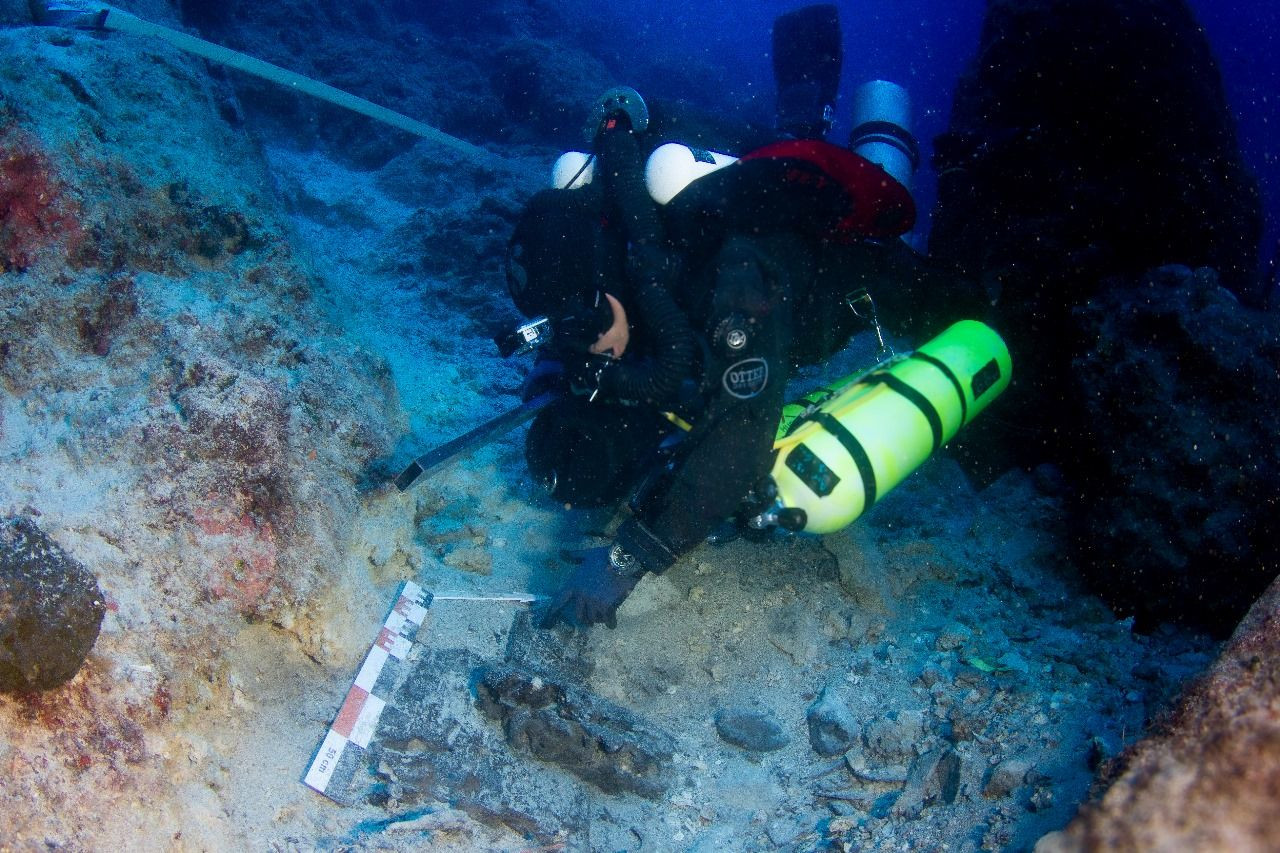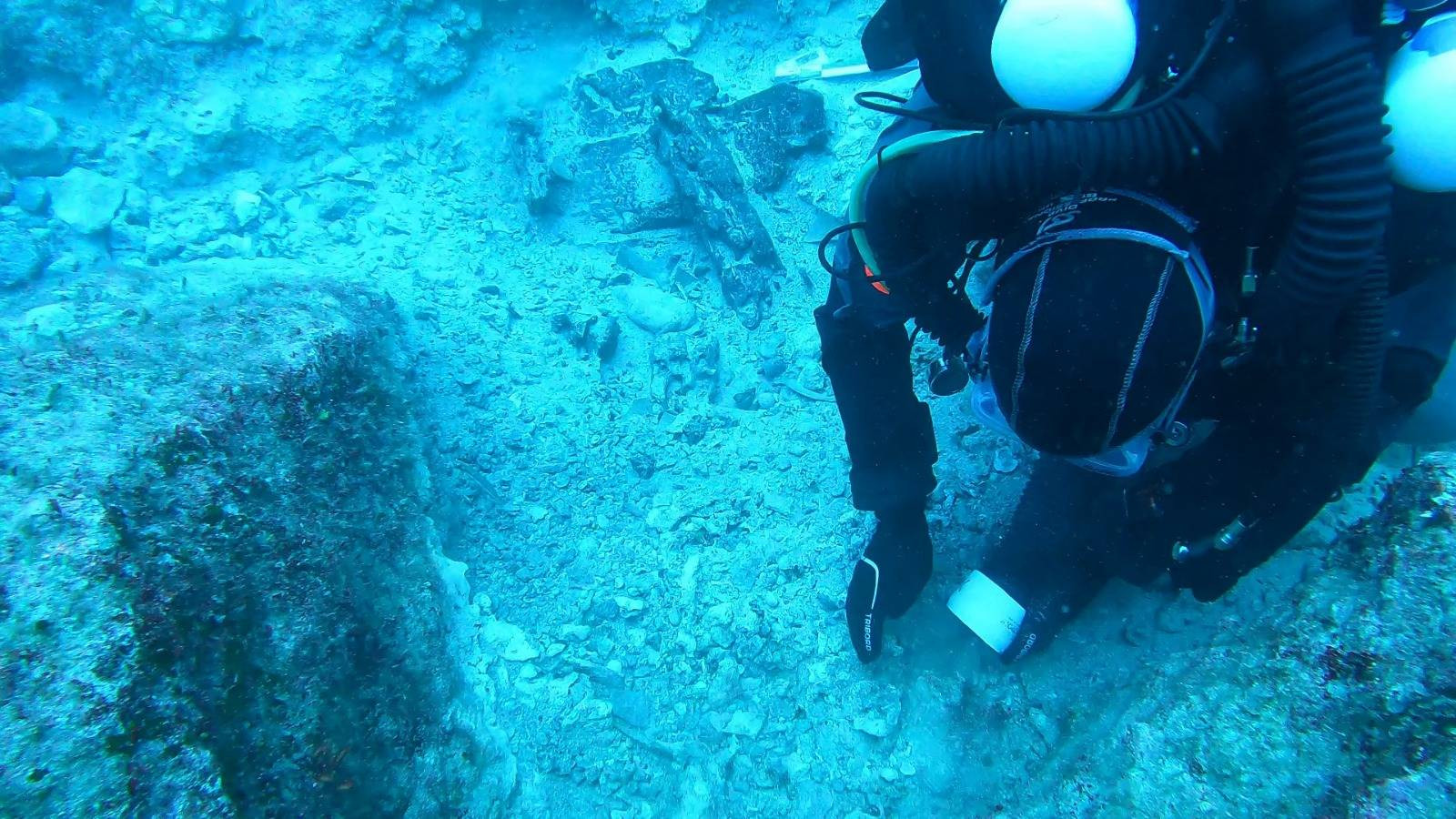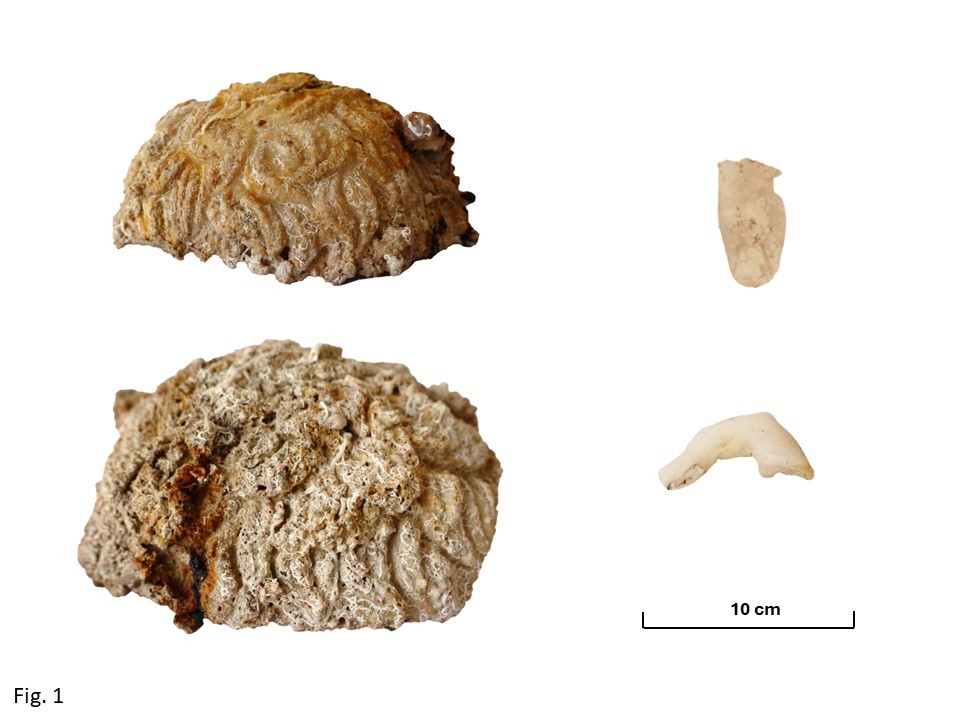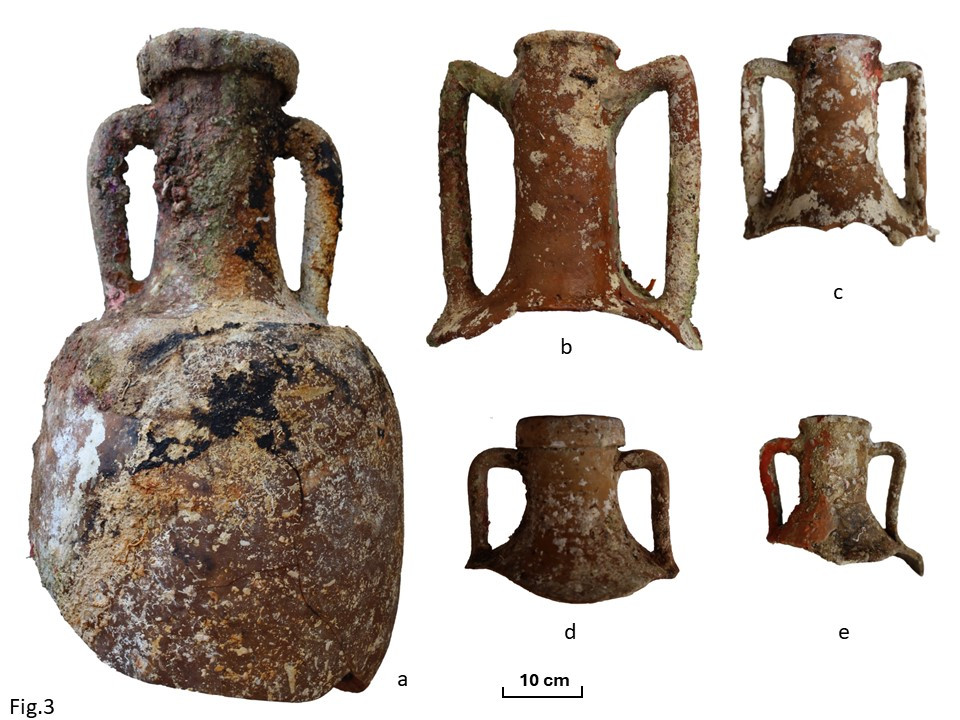How exactly did the shipwreck happen and who do the recovered human remains belong to – Rich findings from archaeological research
The 2024 expedition to the wreck of Antikythera took place between May 17 and June 20, as part of the 2021-2025 research program implemented by the Swiss School of Archeology in Greece and supervised by the Ephorate of Marine Antiquities of the Ministry of Culture.
Exceptionally good weather conditions allowed the team to make significant progress in the field work.
The excavations yielded numerous findings, while of exceptional importance is the discovery of an important part of the ship’s hull.
For the first time since its discovery by the Simian spongers in 1900, the systematic scientific approach carried out by the international research team led by Dr. Angeliki G. Simosi (Honorary Director of Antiquities of the Ministry of Antiquities) and Professor of Archeology Lorenz Baumer (University of Geneva) aims to better understand the site of the famous shipwreck, and to re-examine one of the richest cargoes of ancient ships. The research simultaneously opens up new questions: was there only one ship involved in this ancient maritime tragedy?
How exactly did the wreck happen? Did the human remains recovered in recent years belong to passengers or crew members?
To answer these questions, several techniques were designed and applied:
Planning and feedback were aided by the database and Geographic Information System (GIS) created in previous years. Remotely operated vehicles from Hublot Xplorations and the Coast Guard Undersea Mission Unit were used to monitor and coordinate all underwater operations in real time and to build digital 3D models of selected areas. 3D models of the lifted objects were created thanks to a special scanner developed specifically for the research project by the Hublot watchmaking R&D department.
A specialized manned underwater surface survey methodology was applied to the full extent of the wreck area, spanning two distinct find collection sites 200 meters apart (Areas ‘A’ and ‘B’). The aim was to locate, identify and document in detail the remains of utilitarian pottery and vessels that served transport or storage purposes. Selected representative samples were retrieved for further study. The use of newly acquired closed-circuit mixed-gas diving devices greatly contributed to the efficiency and safety of diving procedures.
A new method of underwater excavation of limited intervention was applied, which yields the maximum possible results. Selected zones of 2x2m area were excavated. and collected all the extracted sediments, which were preliminarily studied in a special micro-geoarchaeological laboratory installed in the field, allowing in this way precise stratigraphic observations, and highlighting the complexity of the site and the different formation processes of the archaeological site between Areas “A” and “B”.
In addition, the analysis of phytoliths and the identification of various resins and caulking materials provided crucial new information about the ship and its cargo, while the detailed analysis of the pottery contributed to a more complete understanding of the wreck’s dispersal picture. Finally, the research team had at their disposal the results of the laboratory analyzes obtained after the completion of the 2023 excavation period, such as bone and lead residues, which contributed to the detailed guidance of the new excavation practices.
Rich results
Ongoing and new excavations opened in both areas (“A” and “B”) yielded rich archaeological material: about 300 objects or groups of objects, including 21 marble fragments (18 from marble statues), numerous fragments and other structural elements of the ship’s hull, and over 200 pottery fragments. Several geoarchaeological samples were also extracted.
The recently discovered part of the ship’s hull
The most important find of 2024 is a structural part of the ship’s hull that combines important shipbuilding features about which until now there were only hypotheses. More specifically, a section of the ship’s reefs was found, including a small number of connected wooden planks that form the outer shell (petchoma) with transverse reinforcements (nomes) fixed in their original position, which are connected in a way that indicates the construction methodology “first the “shell” (shell first) with the original connectors (copper pins) and the outer protective lead coating being preserved in excellent condition. Thanks to this find, the exact location on the seabed and the orientation of the ancient ship are now known. Through the ongoing comparative study of data, the question arises whether more than one ship sank during the same event in Antikythera. The new shipbuilding data recovered and extensive laboratory analyzes planned for the recovered hull samples are expected to shed additional light on details such as the types of wood chosen to build various parts of the ship, its age and possibly its provenance. of.
Second wreck site
A second area of interest (Area ‘B’) is also being investigated due to the concentration of pottery very similar to that recovered over the years from the main wreck site (Area ‘A’). Excavation efforts during this period brought to light new evidence confirming the presence of the remains of a wooden ship, which were found under the crushed cargo it was carrying. These findings were documented and retrieved for further analysis, in an effort to more fully understand the relationship between areas ‘A’ and ‘B’. Details of the seabed surface have been digitally recorded with modern methods, expanding and enriching the available 3D models of previous periods.
Marble and ceramics
The marble fragments found and recovered are evidence for the concentration of sculptural works of art, mainly in the upper part of Area “A” (except for one finger found at a greater depth): two fragments of marble heads of the same type as those recovered in earlier periods, several fingers from at least two upper extremities, two lower extremities, a part of a palm, and fragments of clothing. From the differences found in the quality of the fragments and their anatomical relevance, it can be concluded that they are parts of different statues.
With regard to the ceramic findings, apart from the fragments found during the excavation which were lifted, emphasis was placed on the detailed identification of the typology of commercial amphorae. Already from previous excavations at the wreck, five different types have been recorded: Koos, Rhodians, Pseudokoos, semi-amphorae, Ephesians/Nikandros Group and Lamboglia 2.
The results of the 2024 field survey confirm the abundance of Coan amphorae at the wreck site, as well as the existence of Rhodian and Ephesian amphorae. The Lamboglia 2 amphorae, however, turned out to be much more numerous than expected and are typologically divided into three subcategories. While the known types are found in both Areas A and B, the investigation of Area B revealed the presence of types hitherto unattested in Area A: amphorae from Chios and a Rhodian amphora with twisted handles.
Thanks to the field micro-geoarchaeology laboratory, the visual and microscopic analysis of the ceramic bodies of the amphorae was complemented by the analysis of their components. It also appeared that the dark residue found inside some amphorae was based on mastic, which was used as a coating to seal vessels.
Other pottery vessels discovered this year include a lagynus and a two-handled skyphos (diotos), already recorded from previous excavations, as well as hitherto unconfirmed forms of table pottery found in Area ‘B’.
Partners and sponsors
The research program “Return to Antikythera” is under the auspices of S.A. of the President of the Hellenic Republic, Katerina Sakellaropoulou.
The main sponsors of the research program are the Swiss watchmaker Hublot (Official diving watch, scientific and technical support), the Aikaterini Laskaridis Foundation (technical and in-kind support, academic partner in Greece) and the Nereus Research Foundation. Telecommunication services are provided by COSMOTE, which covers the wreck excavation area and the island with 5G and fiber optic networks.
The research team especially thanks the Ministry of Culture, its services and personally the Minister of Culture Lina Mendoni, for their continuous and substantial support to the research program. He also thanks the mayor of Kythera and Antikythera Efstratios Charchalakis and the few remaining residents of Antikythera for their support and warm hospitality.
The mission team
The activities were supervised by the diving architect Aikaterini Tagonidou and the technician Athina Patsourou of the Ephorate of Marine Antiquities of the Ministry of Culture.
The field survey involved Alexandros Sotiriou, University of Geneva research associate and seabed technician, and a team of diving archaeologists consisting of Michelle Creisher (University of Haifa), Isaac Ogloblin (University of Haifa) and Orestis Manusos, and the specialized divers Nikolaos Giannoulaki, Styliano Matsukatidis, Haris Mitrou and Dimitris Stamoulis. The team was completed with the participation of six members of the Coast Guard’s Underwater Missions Unit (Special Diving Team), consisting of Dimitrios Hatziaslan, Achillea Ganela, Athanasios Keitzi, Dimitrios Kiosi, Dimitrios Kremmidas and Georgios Lytrivi.
The documentation of the archaeological finds, the creation of the 3D models and the updating of the GIS was carried out by Patrizia Birchler Emery (University of Geneva), Orestis Manousso and Timothy Pönitz (University of Geneva), while the field workshop was organized by Isaac Ogloblin, with the support of Yiannis Bitsakis (University of Geneva and Nereus Research Foundation) and in collaboration with the University of Ioannina (Professors Ioannis Deligiannakis and Maria Louloudi). Geologist Yiannis Basiakos (National Center for Scientific Research “Democritos”) visited the team in Antikythera to examine scientific issues related to the wreck site.
Technical support (audio-visual documentation and ROV’s) was provided by Hublot Xplorations team members Mathias Buttet, Aloïs Aebischer and Guillaume Champain.
Source :Skai
I am Frederick Tuttle, who works in 247 News Agency as an author and mostly cover entertainment news. I have worked in this industry for 10 years and have gained a lot of experience. I am a very hard worker and always strive to get the best out of my work. I am also very passionate about my work and always try to keep up with the latest news and trends.














